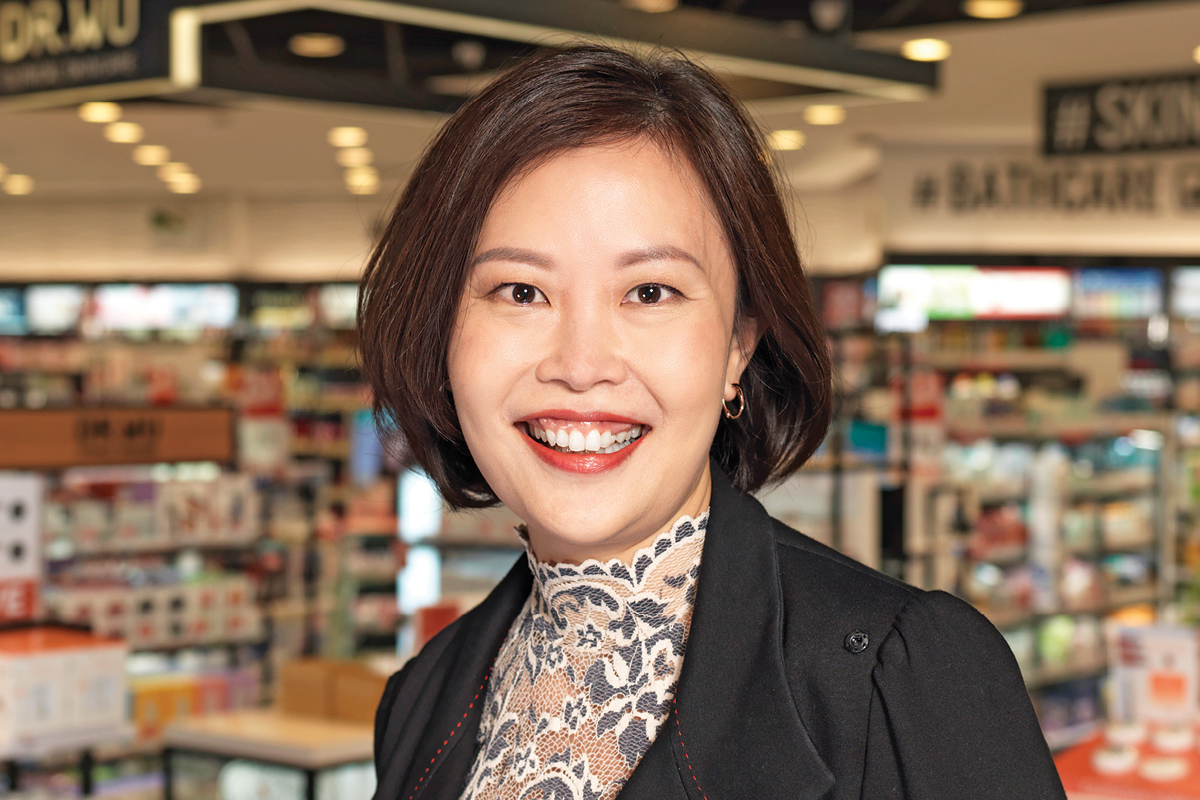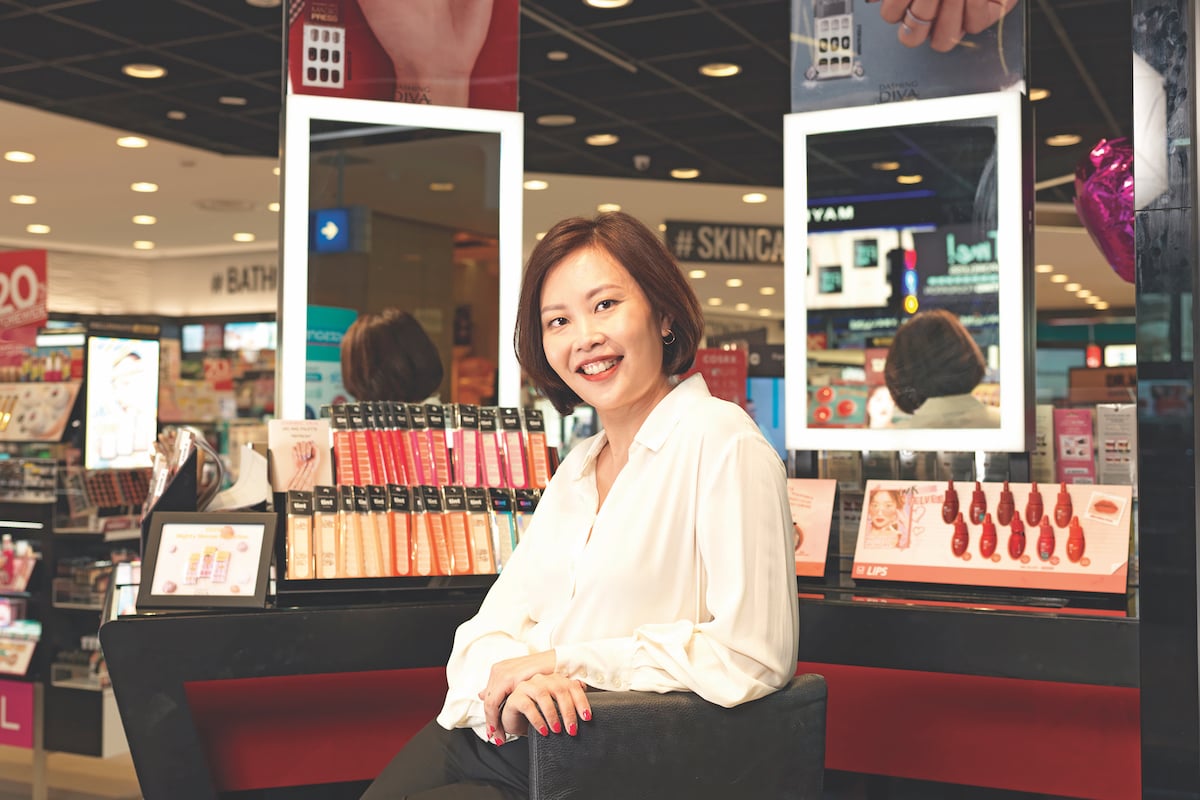When rent is high, GDP is low and the competition is fierce, it takes more than cost savings for a business to survive, let alone thrive. With the retail apocalypse squeezing the life out of shops around the globe and many others operating in the red, Singapore’s go-to retailer, Watson’s Personal Care Stores, is somehow prospering. More than an anomaly, this forward-thinking retailer has nailed down the perfect equation for success.

“O plus O is the way to go,” shares General Manager Irene Lau. “Together, online and offline initiatives can be used to create that seamless customer experience. And the retail players that win will be the ones who can create the most seamless journey between these two.”
The power of branding
Watsons is Asia’s leading health and beauty retailer. Its parent company, AS Watson Group, is the world’s largest health and beauty retail group, boasting more than 15,700 shops in 24 markets worldwide. Having that kind of supportive strength gives Watsons an edge over its competitors – especially when it comes to branding.
“We’re very blessed to be part of AS Watson Group,” Irene beams. “We have strength as a Group, supported by a consistent look and feel across our stores, innovative technology and also the equity of our brand.”
Customers can even use their Watsons One Pass (the brand’s loyalty membership card) to enjoy benefits at any of the Watsons stores across the region, from China to
Hong Kong and Malaysia to Thailand. The retailer’s laser focus on the customer experience is what keeps its physical stores thriving in the digital age.
“It’s all about the continuous enhancement of the customer’s experience in our shops,” Irene says. “From the data we have of our members, we understand their shopping behaviour perhaps more than they do themselves – from category preferences and cross-shopping patterns to their recency and frequency with us. This allows us to tailor
our stores, our products and promotions, catering to them as individuals rather than one huge group of customers.”
Thanks to the data, Watsons was able to refit some of its stores, bringing even more retail excitement to its customers. One such example is the Takashimaya Watsons. It features a unique store-in-store concept that’s segmented into different zones for skin care, hair care, health and personal care, and boasts new coveted brands like Milani, Peri Pera and Foreo. To support Singapore’s small- and medium-sized enterprises, Watsons also introduced two independent local wellness brands: Botanica Culture and Hush Candle.
“We incorporated what was good in a department store with that of a mass retailer like ourselves,” Irene explains. “Giving key brands mini store-in-store concepts allows our customers to have a wider variety of products and a more holistic shopping experience, which is less crowded and allows them that freedom of movement. Each brand also comes with a dedicated beauty adviser who is able to consult customers on their needs, providing information and advice,” she continues. “We’re always trying to create that something extra, which is experience. That is what will draw people into our stores.”
“We incorporated what was good in a department store with that of a mass retailer like ourselves.”
Regardless of how profitable the stores are, it would be foolish to ignore the online-shopping craze that’s taking over the globe. A seamless journey across Watsons’ physical shops to its online presence was just the ticket for the innovative brand’s future success.

Click-happy shoppers
With an extensive marketing background and previous experience at Watsons Taiwan, Irene was able to catapult Watsons Singapore from the traditional retail space into the digital age with her keen understanding from the customer’s perspective. And her timing was impeccable.
“The channel shift with ecommerce was already happening in Singapore, and happening very quickly when I came aboard,” she remembers. “I wanted to make sure we stay ahead of the curve. I’m of the mindset that once a person figures out how to buy something online – and this even applies to someone in their 70s like my mum – then there’s never any turning back.”
Being able to shop from home in pyjamas with a glass of wine in hand is hard to beat. The convenience of not having to lug the shopping haul home from the store is also a huge bonus. So, while brick-and-mortar store closures are becoming more frequent, it’s not because buyers are spending less. It’s because they’re spending more online.
“I wanted to make sure we stay ahead of the curve.”
“The speed of ecommerce growth isn’t modest,” Irene explains. “It’s going to be threefold year-after-year growth, simply because the more people that touch this whole ecommerce engine, the more they’re going to be converted and shifting more of their spending into this area for sheer convenience and a larger variety of products. So we are focused on growing this O-plus-O strategy very strongly.”
With online-only shops cropping up on the regular, luring click-happy shoppers with big discounts thanks to their next-to-nothing operating costs, it can be hard for physical shops to compete. But it’s definitely not impossible.
Instead of seeing ecommerce as only a disruption to the industry, Irene was able to change her perspective and see it as an opportunity. “The online world doesn’t have the constraints of a physical store with limited shelf spaces,” she says.
“It gives us the potential to offer more variety across categories we don’t typically carry but that are still relevant to the core women customers that we serve. And it gives us the ability to also jazz up the way we run promotions online to differ somewhat from offline, giving customers the option to shop either channel to be O plus O.”
It’s also allowed Watsons to grow its offerings in a big way. Seeking to better cater to a huge part of its customer base – women aged 18–60 years old – led to an online product strategy dubbed Watsons+, where ‘+’ stands for the thousands of new products across new categories that appeal to both male and female customers.
“Online, you can find additional categories you never thought could be possible for Watsons to carry,” Irene says. “It’s given us so much room to expand into categories that women and even men really want, like household or sport and nutrition products. We also cater to much more niche segments by offering premium skin care. It’s about keeping it relevant to our customers. The more relevant we are to them and their lives, the more likely they are to spend with us.”

It’s also all about working hard to ensure each customer remains a customer for life. “Competition is stiff,” Irene shares. “Customer lifetime value is our true focus. We’ll have teenage customers who start out buying cosmetics and turn into 20-somethings buying skin care. Then they become mothers and start buying diapers from us. Their lifetime value just keeps getting bigger and bigger. And because we’ve remained relevant to them, they’ve stuck with us.”
Transforming an indsutry
Transitioning to digital hasn’t exactly been easy for Watsons Singapore. Due to the traditional nature of retail, many of the brand’s employees lacked the technical skill set it took to understand the digital world. However, there was overlap and that’s what Irene cashed in on to grow the talents of her team.
“Retail is a very old-fashioned industry. It’s been around forever,” she points out. “I found the mindset to be more conservative and less innovative. So I had to start retraining my team’s entire mindset about the online world. Ecommerce is merely transiting people’s traditional roles into that of a more multichannel role because some of the skill sets are exactly the same. It’s just the mindset that has had to change.”
Leading by example, Irene was able to navigate her team through uncertain waters into the digital space. “I’m glad that everybody is now very aware of this O-plus-O change and how we drive this faster,” she says. “The organisational culture had to also undergo disruption. It requires a leader to be less conservative and instead hyperaware of the changes in the marketplace, not just locally but globally. And to implement changes to be able to grow the top line and not be focused just on cost savings. For every cost incurred by change, there’s also the opportunity cost of resisting change.
“It needs to be about innovation. It needs people who aren’t afraid of making mistakes. It takes being really gutsy about dropping the traditional in order to try new things. It’s ultimately about the customer.”
The golden rule of leadership
Everyone knows the golden rule: ‘Do unto others as you would have done unto you.’ For Irene, that’s the approach she takes to leadership – except, in reverse. “I always try to reflect and remember what made me frustrated,” she explains. “I hated micromanaging bosses. So that’s something I avoid walking into. When I feel I’m going too deep, I pull back and allow them to just do it.”
It’s not always easy though. A high level of detail is required in retail, which is something Irene says not many people realise. “That’s where I can become micro because I want to help and make sure everything is just right,” she says.
However, she resists the urge and instead tunes into the wisdom her mentors imparted on her. “They helped me decide the kind of leader I want to be,” she shares. “My style is one of a more personable, open-door kind. I like to be very involved in the day-to-day matters. I make sure my team hears the same message again and again and encourage trying new things. The more successes that are gathered along the way, the more people realise that there is truth in innovating.”
Unlike the number of modern leaders touting “strategy this” and “strategy that”, Irene goes against the grain, saying it’s actually the execution that’s key. “Strategy is a very overused word,” she says. “Everybody talks about strategy, but I’ve seen so many strategies hang in the air that never materialise or materialise correctly because of the inability to translate them into execution. The key to a successful strategy is 100% execution perfection. And that’s the hard work.”
Data-driven dollars
Innovation is key to Watsons’ bottom line. Irene credits customer spending data and store-space maximisation technologies with driving profits. “We have a team of data-driven people who guide us as to where our sales are coming from, how much we are giving away and how much we are driving, which gives us direction to move forward,” she says.
“Our data stream is a flow of quick value for us. By mining this data, we are able to really understand our customers in a very detailed and in-depth way.”
Using this data, Watsons has given its shops different personalities. Take the shop at Bugis Junction, for instance. Data showed that customers here were younger and buying heaps of cosmetics. So Irene took that data and refitted the entire shop, giving more than half of its space to the cosmetics category.

Similarly, in Watsons so-called ‘heartland’ neighbourhoods, where the masses of Singapore live, data showed a lot of empty-nesters call these areas home. In response, Watsons outfitted the shops in these locations to focus more on health to cater to an ageing population.
“If you’re not selling the right things to the right people, then it doesn’t work,” Irene stresses. “I call it store segmentation according to what customers are buying. Again, it all boils down to increasing the customer lifetime value.”
“If you’re not selling the right things to the right people, then it doesn’twork.”
Alongside the customer-driven data, Watsons also uses micro-space data. This helps the retailer see how many metres in each store are used and if those spaces are productive. With Singapore rents consistently on the rise, utilising space smartly is extremely important.
“If we can maximise every inch of space, then that will translate back into sales,” Irene shares. “And, of course, if we’re selling things that customers want to buy, that naturally translates into sales also. So these things connect together in order to drive our bottom line. The additional dollar from each customer is where I see retail being able to survive.”
Growing business together
Similar to most top-performing companies, Watsons considers supplier collaborations to be absolutely essential for its ongoing success. These partnerships work to make sure both parties come out on top. How? Well, they each have something the other wants.
As for Watsons, the mega-chain offers strength in numbers, a solid reputation and the bonus of an in-store and online platform. The suppliers, meanwhile, have the brands and the power to make exclusivity deals with Watsons. Together, it’s a partnership made in shopping heaven.
“We really depend a lot on key suppliers to support us in order to be able to grow business together,” Irene says. “When our suppliers give us exclusive products or are exclusive brands that only Watsons carry, then we overexpose those brands across our marketing channels. With Watsons being O plus O, we’re also able to give our suppliers the ability to partner with us in both channels where we can win together.”
Being successful together is important to Irene. Any other way and she said it just wouldn’t work. “I never want to be the only one to win. That would leave a bitter taste in their mouths,” she explains. “We have to negotiate hard, but we have to be fair. It’s never a lopsided game where one party gains at the expense of the other. We all have P&Ls to run.”
The piece de resistance
The retail industry is changing at lightning speed. And it’s harder and harder for businesses to make it in this cutthroat space. Value shops are popping up left and right around the globe, undercutting shops who’ve been around for ages. Just look at stores like Payless ShoeSource, Forever 21 and Gap, they’re disappearing more and more each day as shoppers spend elsewhere, looking for the best available deal. However, these budget shoppers can’t be blamed – who doesn’t like to save money?
“It will always be a notion that appeals to customers,” Irene says. “Along with ecommerce, small markets, very low growth GDP and the outflow of money because people are travelling, it’s really challenging to drive the top line.”
But Watsons shows it is possible. Part of the success of its stores is that they have that something extra – that piece de resistance. And, according to Irene, sometimes that something extra laughably borders on insanity.
“Growing that next percentage point is a big challenge, and it’s really only through a good strategy with good execution, teamwork and relentless tries every day, looking for new opportunities, looking at the data and refining places where there are still opportunities that will get us there,” she says.
“It’s not easy. It needs passion, and it needs people to be a little bit crazy to actually want to be in this retail space; there are certainly easier jobs if you’re only after the pay cheque. I have the right amount of crazy and, thankfully, I have a team who are probably even crazier. I’m blessed in that respect.”


